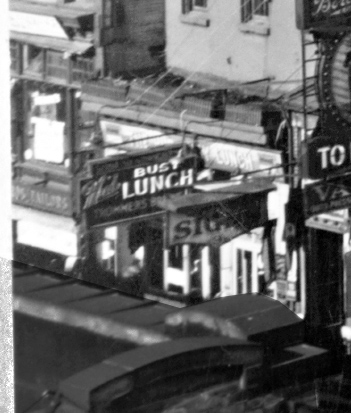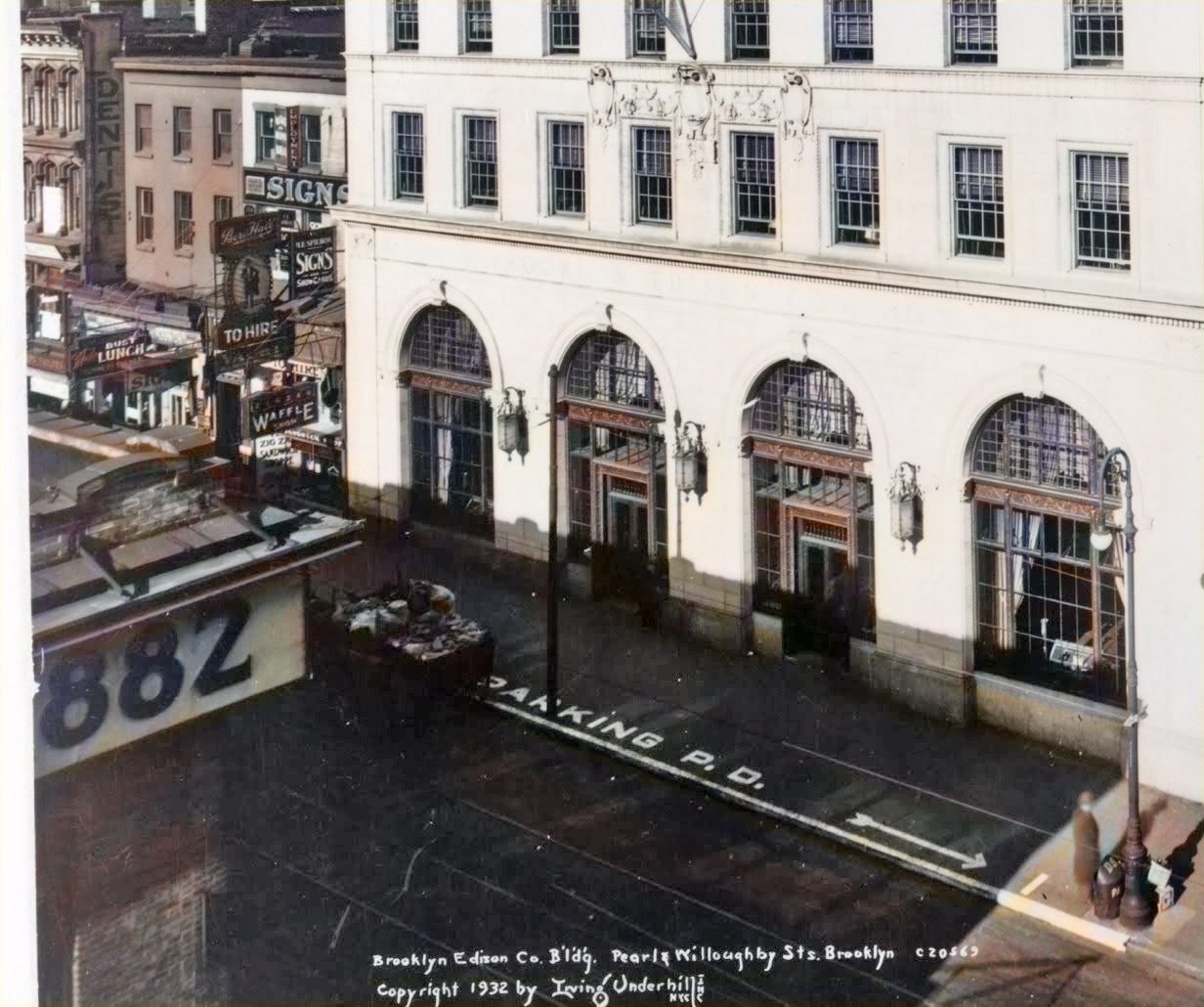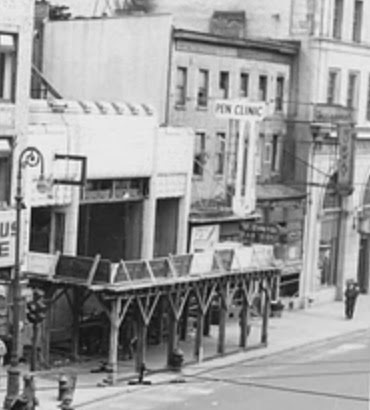Here are pictures for “John’s”, located at Willoughby Street, Brooklyn, from May 1925. A regular and favourite New York City haunt of H.P. Lovecraft, from that date.
Here we see Willoughby at numbers 5 – 15 on part of a Library of Congress architect’s photograph made in 1932. It shows the Edison Company’s 1924 offices, with the shadows lifted by myself to reveal a shadow-hidden truck and also some of the detail on the adjacent stores. A corner of a closer building’s roof partly obscures the view.
No. 7 is on the right. Still offering “Lunch”.
No. 5 can be identified by its architecture as seen on other pictures, and is half-seen on the far left of the picture. Circa 1924 it held the office of Lovecraft’s New York writer friend La Touch Hancock. Then we simply count along the row. Numbers 11-13-15 were obviously subsumed by Edison into a single “No. 15”, a building which is still there today and has the same number. Some modern sources erroneously date the Edison Company offices here to “1960”, but that is the date of a building record-photo, not of the building’s 1923/24 erection.
This show us what the street looked like in Lovecraft’s time, with the Edison building there already by 1924-26. Here is the detail, and it suggests John’s was no longer John’s by 1932. I seem to recall that Lovecraft mentions somewhere in a letter that it had closed by the 1930s, but I can’t find that mention. By 1932 it certainly has a ‘cabin’ frontage added, and is the “Busy Lunch” with what might be a “Trommers” or “Drummers” Bar incorporated. 
It feels like John had departed, and indeed he had. On page 937 of Letters to Family Lovecraft states of July 1931…
All three now set out for dinner — at the old Bristol Dining Room in Willoughby Street near Fulton, next door to the now defunct John’s, which was my Brooklyn headquarters for spaghetti in the old days.
By the late 1930s it was a Wines and Liquor store, as partly seen on the right of a badly mis-placed 1940s.nyc picture. A Lovecraft-like man crosses the street to the art-deco “Automat” which had by then replaced 3-5 Willoughby Street.
A further picture I have shows that No. 7 was still there in 1954, along with No. 1, and 3-5. The Automat at 3-5 was then being gutted and — appropriately enough — the former John’s appears to have become a “Pen Clinic” for ink pens. Lovecraft, always in pursuit of the perfect ink pen-flow, would surely have approved of what appears to have been the final fate of John’s.
1954, what looks like the final years for numbers 1 to 9.
With these pictures in hand I’d say that the modern layout places the site of No. 7 about at the very edge of the plaza, or maybe a little further out into the highway…
The plaza is small, cramped and over-cluttered… and thus the safest hassle-free place (the city is currently subject to a massive wave of street-crime) for any Lovecraftian tour-guide gathering and talk would appear to be in the far corner of Columbus Park. Which is seen here, after my having ‘virtually’ crossed the highway from No. 15 and its small plaza. I’ve here indicated the continuing line of the ‘lost’ Willoughby Street in a soft orange…
What did it look like in circa 1925-27? We can’t know, until more pictures are found. But we do have the Subway Construction pictures of 1916, presumably made on lovely large glass-plates so as to forestall any spurious compensation claims in litigious New York City. Good prints of these can now be had from the city’s Transit Museum. They show a place very different from the makeover it had by the late 1930s, so I guess ‘the unknown 20s’ are some way between the two sets of pictures.
But we should be thankful we have three very good pictures of No. 7 as a Hungarian restaurant in 1916, with various vacant units around about. The place would have made a natural transition to an Italian eatery, with newer signs in a slightly more 1920s style and probably a spruce-up in Italian type colours, probably red and green and white rather than what might have been a Hungarian blue and white.
Here we half-see No. 7, but head on, while picturing No. 9. Also seen is a part of No. 11, which by Lovecraft’s time had been lost to the Edison Company’s 1924 offices.
The full circa 1900 run from the original 3 – 15, including the Bristol Dining Room which Lovecraft patronised in the 1930s after John’s closed, can be seen here…
And finally, this wonderfully clear 1916 view of the entrance, looking down the foot of Willoughby toward the Citizen building (hardly to be seen) and the Elevated railway as it curved around and into Fulton. I’ll colourise this at some point, but automation doesn’t even remotely do it and I don’t have the time to do it justice at present.
It was still the same Hungarian place in 1918, when a further small picture shows the subway air ducts being dug.
Some of the (to our eyes) superb signs and sign-writing had no doubt gone by the mid 1920s, perhaps some of the lower vacant units would have become fruit-sellers and the like, and the whole corner would have had a distinctly more seedy and gangster-ish feel about it. Especially after John’s opened. On which, more in the next post.










